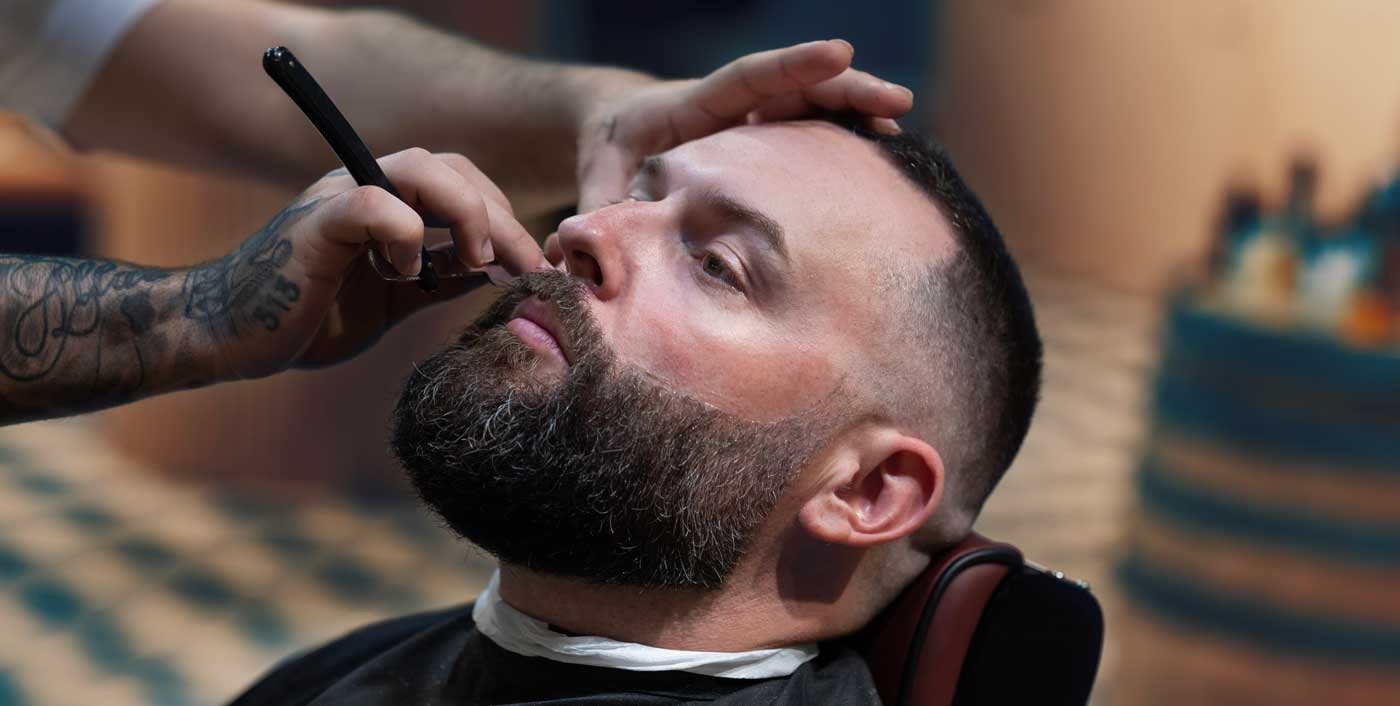Men learn to trim their beards by trial and error. This means a lot more shaving and re-starting.
We are here to ensure that this doesn’t happen.
Our collective experience of Beard Trimming in NYC, spanning decades, has been compiled into one beard guide. We’ll show you how to avoid common mistakes when growing and maintaining your beard, so that it looks great no matter its length.
How To Trim a Short Beard
Skip to the next section if your beard has already grown longer than 2 inches.
When we speak of trimming a short mustache, we mean a beard shorter than an inch.
This is the place you will be for your first two months. Hair grows on average at a half inch per month.
Short beard trimming is about creating boundaries for your beard.
You don’t have much length left to trim at this stage. It’s normal for your beard to still look a bit patchy. Keep this trim focused on the outer edges of your beard.
The short beard trimming can be tricky. Because you have less beard, every line and cut will be more visible. If you do make a mistake your beard will still recover quickly.
How To Trim a Medium and Long Beard
You’ve survived several months of growth. Your beard is thicker and has grown nicely, but it may be a bit longer than you’d like.
Here’s how to trim and clean a beard.
To avoid repetition, we have grouped together the steps for trimming a long and medium beard.
1. Prepare For The Beard Trim
It’s not necessary to shower to get a natural, clean beard. You can help your beard to sit naturally by giving it a good rinse in the sink.
To shape your beard, use a Beard Comb. Do not fluff your beard, but rather shape it the way you normally wear it. This will help you determine where to trim your beard.
2. Remove Bulk Off The Cheeks
As your beard grows longer, it begins to grow away, creating a wide profile. You want your beard highlighting your jawline and not making you look like you’re a chipmunk getting ready for winter.
Grab the electric trimmer, along with all of its guards. You don’t want to accidentally remove too much hair. So, put a larger guard on your clippers than what you need.
Start at your sideburn and run the clippers straight down the side of the face. Extend the clippers beyond the jawline. Do not curve your head inwards towards the neck.
If you find that the clippers are not removing any hair, try a guard one size smaller. Repeat this process until you reach the desired length.
3. Take Some Length off the Beard
This step will actually reduce the length of your facial hair.
Decide where you would like the end of your beard and how long to trim it. Take your electric clippers, and make small, slow cuts perpendicularly to your jaw. Work straight backwards from the front of your beard to the neck.
4. Clean The Edges
After you have cut your beard, take a look at how it looks.
Your beard may not be as square-shaped as you would like. You can now clean up your edges, the points where your back beard meets your bottom beard. This area is located below your jaw hinge.
You want to soften that angle and make it more natural.
5. Clean The Neck
You can find the instructions on how to trim your neckline above.
As your beard grows, you may want to lower your neckline. Your neckline should be at or above your Adam’s Apple.
When your beard is long enough to cover the neckline, you don’t need to worry about it anymore.
6. The Flyaways – Trim the Flayaways
Use your Beard Comb to comb through your beard and remove any hairs that may have gotten out.
After you’ve gotten your beard to lay naturally, look for any hairs that are visible protruding from your beard.
These overzealous hairs can be trimmed with your Beard Trimming scissors.
Make small cuts to the hairs that are longer than your rest of beard. Look for any stragglers that you might have missed. Comb and brush your beard once more. Repeat the process until you’re satisfied.
It’s easy to overdo it when trimming the flyaways.
7. Point Cut the Bottom of Your Beard
Trimming the beard can create very sharp, blunt lines at the bottom. This may look unnatural or too manicured.
Use your scissors to make a point cut along your bottom beard edge. This will help you achieve a natural-looking look. Holding the scissors straight up and towards your chin, make small snips using the tip.
This will not remove length from your beard, but rather soften the bottom edge. This step is similar to how you would shade in art class.
8. Trim the Mustache
After trimming the beard you can move on to the mustache.
There are many ways you can trim your’ stache. You can use scissors to trim any hairs on your mustache that fall over your lips. You may not need to if you are going all walrus.
9. Brush and Style Your Beard
Use your Beard Brush and Beard Oil to shape your beard.
Here’s your chance to evaluate your work.
You’re ready to go if you like the way your beard looks. If you don’t, make sure to touch up any spots that are too obvious.
We recommend that you wait a day after you have finished to assess how you feel. Most often, your concerns will vanish once you’ve styled and washed your beard. This method will prevent you from trimming too much.
Advice: Brush and comb your beard often throughout the process of trimming. Always trim less and use small, conservative movements.

